
In our previous entries, we've discussed specific major new features of Crusade. For this entry, we're going to go through a guided tour of what's new in Crusade over GalCiv III in terms of features and gameplay. Strap in!
Let me preface that this is long and probably a bit full of typos. I wanted to get this out to you as soon as possible. It's long, but I hope you like it! -brad
Prior to the age of digital distribution, Crusade would be a sequel. It's that big. There is a bigger difference between Crusade and GalCiv III than there was between GalCiv III and GalCiv II.
Crusade is an expansion that will be released as a DLC for Galactic Civilizations III (www.galciv3.com), which means you do have to have GalCiv III already, but Crusade itself will only be $19.99.
Because of the immensity of the changes, I'm going to do this in two parts and mostly as screenshots. I will leave it to other, smarter people to determine which of these features matter the most. In the comments area, please feel free to comment on which things you care about the most.
The Civilization Builder
Immediately at launch, you know something is up. There are two conspicuous new entries:
- The Ship Designer
- The Civilization Builder

The Ship Designer and the Civilization Builder
We already had a dedicated article (DIARY 2: Civilization Builder) on this, but it has continued to get better and better since then.

Via Steam Workshop, nearly every ship design ever made is available, including this fan made version of the iconic Omega Destroyer from Babylon 5.

Players can customize what the citizens of their civilization look like.
Because players design their own ships and can share them online so easily, I feel I must emphasize: Stardock does not include popular sci-fi style ship designs with the game. We simply provide a tool that lets people create any type of ship or civilization they want by giving them lots of ship parts. There is no pre-made Tie-fighter part or Star Fury part or what have you. People have made robots, snakes, Giant Rick, and of course, many excellent versions of favorite sci-fi starships.

At any time, I can click a button and subscribe to one of the over 10,000 fan made designs that have already been submitted.
My screenshots tend to feature Babylon 5 fan art because I was a Babylon 5 fan going all the way back to Usenet. If you don't know what Babylon 5 is, you should check it out.
I also highly recommend you check out this site, as it has been a major source of inspiration for me over the years.
Anyway, the Civilization Builder does what it sounds like, right down to even controlling what the aliens say to each other.
Ship Designer

Animated, organic ships are possible too.

On the left you can see all the pieces. The red dots indicate where you can connect parts to.
New and Updated Races
We include two new alien civilizations, as well as the Terran Resistance. We'll talk more about the TR later and go into some detail later about the new civilizations.
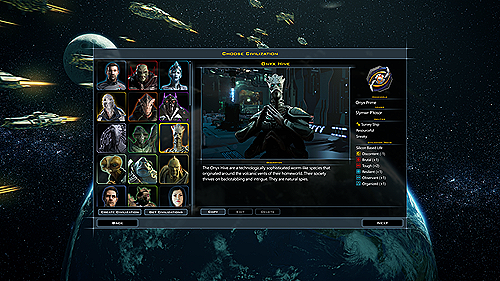

Updated Races
These are just examples, but we've changed a ton about each of the existing civilizations to make them play much more differently than before. Playing against them now is much more unique.

The Thalan are Time Travelers, which gives them access to special techs

The Krynn are now "devout"

Because the civilizations are substantially different based on traits, we make sure to give more detail about them when choosing opponents
Races no longer get a "tech tree". Instead, tech trees are procedurally generated based on the traits of your civilization. Modders should love this, since now they can just submit a bunch of new techs that have race trait requirements and they'll "just show up".
The new Economy
The new UI has a lot more relevant information and is much more intuitive. Because of the overall re-balancing and pacing changes, the early game keeps you busy with lots of interesting choices.

You no longer start with a shipyard. That is one of the early choices your civilization will need to make.
Crusade's new economy means that each decision matters. A lot.
Most of you are familiar with Earth, so we'll use Earth on turn 1 as our example.

Also, because population grows slowly, be careful about just cranking out colony ships.
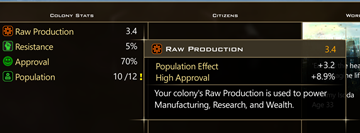
Everything starts with raw production, which is the square root of your population + any bonuses (such as happy people) or penalties (unhappy people).
Your construction, research, and money come directly from that number X any specific bonuses attached to them.
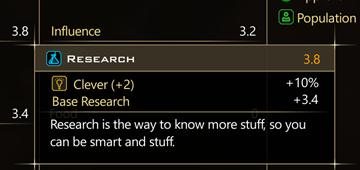
Since Earth has a lot of people at this point (10 population units), you get 3.33 base production, plus a little something extra because people are happy.
Then you have to decide what you want to build first.
-
Shipyard: Always tempting and about half the time it's my first choice, depending on what I start out with.
-
Computer Core: You only get 1 of these. It provides 2 research points plus 1 for every level it goes up. So your home planet may not be where you want to use this.
-
Space Elevator: You can (and should) build one on each planet. Why? Because it's a goddam space elevator. It also adds +2 to general construction on the planet and gets another for every level it goes up.
-
Central Bank: There can only be one of these, but it's +2 to the planet's income and it goes up +1 for every level.
So which of these should you build first? The answer: it depends. On this example, I'm going to build the compute core because it gives me +2 levels to research. It will make that computer core do +4 total, which is more than doubling my research on the first turn.
Also in this example is the Prometheus Stone Extractor, which would increase my wealth by 1 and give me Promethion (a resource used for higher end research stuff), but it's not not compelling in this case. Aid Research is a Project I can do that will give me 25 research points, which is nice, but not something I want to do right now when I can build that computer core.

Rather than having to mess around with sliders, players specialize citizens to be leaders who can be moved into any area of the player's economy to give it a boost.
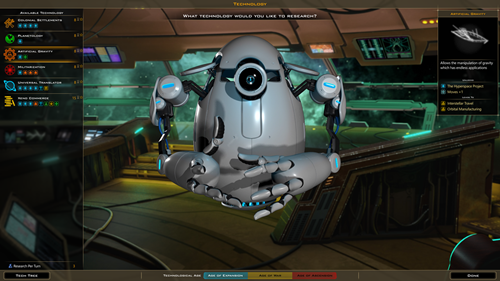
The new research screen provides a straight-forward view of what technologies you can access and why you would want them. Each tech is designed to provide a very tangible benefit.
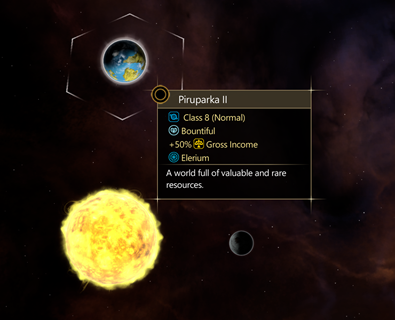
Because resources are so crucial, planets will now disclose what they have on them before you colonize.
Galactic Citizens
By far the biggest new addition to Crusade is the concept of Citizens.
Rather than using sliders and dials to manage your economy, you instead specialize your citizens in the area that you want to focus on. Every 10 or so turns, one of your people rises to the top and becomes a galactic citizen.
Once players have a citizen, they can choose a specialization for him or her. These specializations depend on many factors including your race, ideology, and more.
Specializations include:
- Administrator: Allows for the construction of more Starbases, Colonies, and Survey Ships.
- General: Allows for the construction of Transports for planetary invasion.
- Spy: Allows you to spy on your opponents and sabotage their planets or protect yourself.
- Scientist: Boosts your research.
- Commander: Can be assigned to a fleet to boost its speed and offensive power.
- Leader: These citizens only work for the central government, but can be switched into any area of it.

When a new citizen is available, players can choose an area for them to specialize in.
Citizens can work for your central government, where they provide a civilization-wide bonus in some areas - OR, they can be sent to a specific planet to provide a massive boost for that planet in a particular area.

Citizens, when assigned to planets, must travel to the planet in question. The further away, the longer it till take him or her to get there.
Players with large empires will tend to want to keep their citizens in their central government.
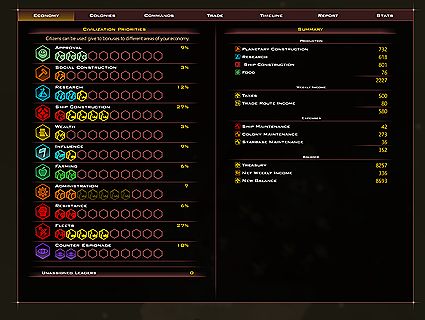
Over time, the priorities of a civilization become clear based on where they put their citizens.
Early game, most players will settle citizens on key worlds. On larger maps, players will often gravitate to specializing in leaders (see the gold leader icons above) so that they can quickly adjust their global economy.
Espionage
What are your opponents up to? Use Spies to find out what they're up to and eventually steal their technology. Alternatively, use spies to sabotage key planets.

Spies can tell you a lot about a given civilization, including who their primary enemy is, key stats on their planets, and much more. Once you know everything there is to know, your spies can start stealing tech.

Putting a Spy on a given planet dramatically reduces that planet's overall productivity. The tile you place the spy on is completely disabled as well. A single spy on a key world can knock that player's economy for a loop until they use one of their own spies to kill them.
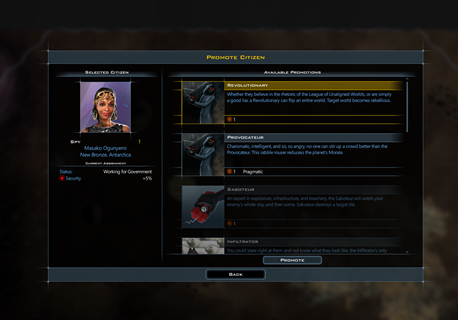
Spies can do some pretty awful things to a player if they are left on the planet long enough.
New Starbase System
Players construct modules on the starbase itself rather than sending additional constructors. Different modules cost different amounts of various resources, requiring players to trade for them (most common reason for AI trading).

No more constructor spam. Starbase modules simply have a resource cost. If you have it, it's yours.

The Starbase market requires a Techapod hive. Those are rare and only found on certain planets. You will have to find someone who has it and trade with them (or conquer them).
New Diplomacy System
Diplomacy in strategy games is always a challenge. You want it to be powerful, but you also don't want it too easy to exploit the players. Because Crusade's general focus is now about obtaining resources, we had to rewrite the diplomacy system in order to make it intelligent and fun to trade with, as there is a lot more trading.

This had to basically be rewritten in order to properly handle the new resource system. This, in turn, required us to create a simple but effective bar that shows up above your trade to tell you how close to being equal the trade values are.

Thus here, I'm being too generous. So I can go ask for more money.

Now it's fair. But the AI calculates the value of every tech and compares it with its treasury.
For example:
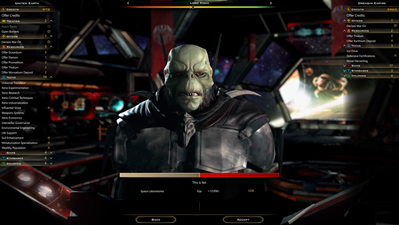
The Drengin value Space Labs for $1230.
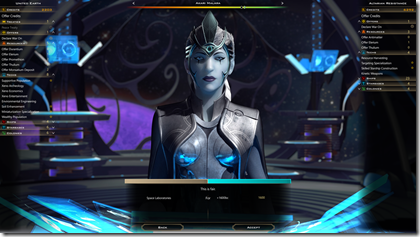
The Altarians value them at $1600.
Why the difference? Lots of reasons including that the Altarians are more concerned about research techs, and have more money, and like you more, and so on.
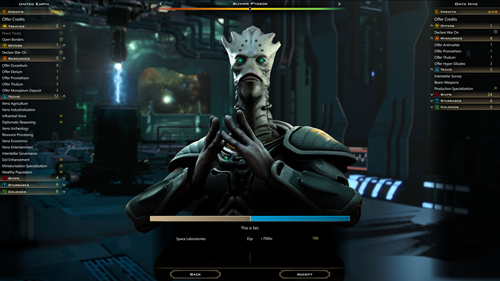
The sneaky Onyx only value it at 700. Do they know something you don't?
Similarly, if you're really smart, you can use the system to figure out what strategies they use based on what they value different resources at.
Generally speaking, the trades are a lot more sophisticated because the AI has a self bartering system to prevent it from wasting the player's time (or other AI's times). It doesn't come to you until it has put together a reasonably good trade.
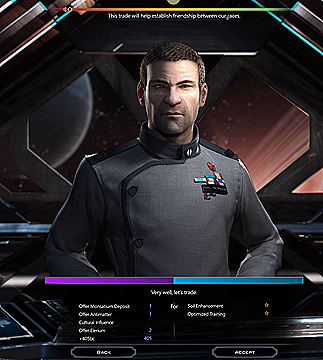
This is a trade deal the AI put together to present to the player.
A new vision for the third act of 4X
The late game in PC strategy games is notoriously grindy. This was a challenge we wanted Crusade to address.
Let's take a closer look at how the very term "4X" advertises the seeds of its own demise:
- Explore. This is fun! Hooray!
- Expand. Still pretty fun.
- Exploit. Can be fun if done right.
- Exterminate. Oye. I either know I'm going to win or I know I'm going to lose.
So how do we mix this up and move things along?
We do this in a number of ways, some of which are obvious...in hindsight.
Reusable Transports
For example, in every Galactic Civilization game you invaded planets with a transport ship full of soldiers. When the invasion was completed, the transport was consumed. But why? In Crusade, the transport isn't consumed. One of the most tedious parts of a 4X game is the effort in conquering planets, cities, etc. But it shouldn't be tedious. If they're militarily finished, then taking their planets should be quick and easy.
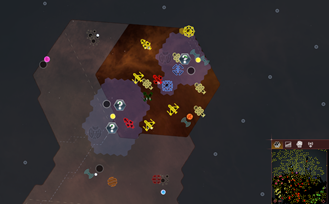
Being a native 64-bit game, GalCiv III: Crusade has map sizes that are insanely big. This makes it imperative that the late game be worth finishing.
Citizen Promotions
By late game, players will have quite a few citizens. If the player has the right resources (which means, late game) they can promote their citizens to become incredibly powerful. These promotions are typically a one-time act which results in the citizen retiring. But in return, you can help finish someone off or buy yourself a last desperate chance to turn things around.
A few examples:
- The Privateer: Trying to win an alliance victory but not powerful enough to take out the one hold-out? Promote your Commanders to Privateers, which will convert your most powerful ship into a Pirate that you can control to help your more powerful friends take out the hold-out.
- The Epiphany: You can sacrifice your scientists to instantly research late game techs. Going for a tech victory, but the Drengin are slowly destroying you (or alternatively, you won't want to have to grind through another 50 turns to get there)?
- Crunch Time: Sacrifice an engineer to instantly finish a ship at your home planet or at at whatever planet the engineer is stationed on. Your mega ship designs can become become a reality.
- Influence Burst: Sacrifice your Celebrities to get a huge influence burst on your home planet or whatever planet they are stationed on.
Each of your citizen types has at least one promotion. Early and even midgame, you won't have the resources to use them, but late game is a different story.

Some of the Promotions we are testing now...
Alliance System Upgrade
The base game has alliances, but they didn't tend to have the teeth that some players wanted them to. In Crusade, Alliance treaties are enforced, resulting in those who don't obey them being roundly hated by everyone.
Civilizations will actively band together to deal with evil (from their point of view) and to try to swiftly wipe it out late game.
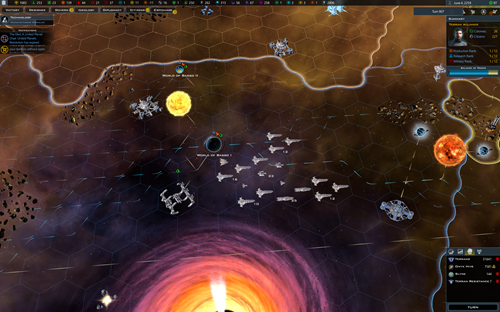
Late game, you and your allies may face off against opposing alliances in epic galactic wars
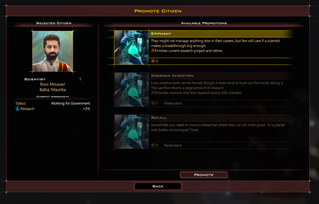
Get that tech immediately.
Missions
There's never a reason not to be building something from your shipyards. There's no concept of wastage so you might as well just build something at all times. Worried about micro-management? Queue up a bunch of missions:

Your shipyard can now be used by the "private sector" to send out various types of missions that can benefit your civilization. This eliminates the need for a "governor" or an "auto build" system, which drastically reduces late game micro management.
You can send out missions from your shipyard. These are private sector efforts so you, as the "government," don't have to do anything other than grant them permission to use your shipyard.
What techs, ideologies, etc. you have determine what missions are available.
The Research mission goes off and gets some tech for you. Bear in mind, these aren't a matter of just building it and getting free stuff. The missions actually do go out somewhere and only when they get to wherever they're doing do you get the reward.

There he goes!
Invasions
Planetary Invasions tend to be an all or nothing affair. In Crusade, we try to make sure that most of the time, once a planet's space force is eliminated, taking the planet is pain free.
However, players can station garrisons on their planets. Here's how it works:
Unlike in the base game where your population is simply conscripted to board an invasion transport or die against invaders, players instead use legions, which are produced through a number of different means:
- Specialize a citizen as a General and you receive 5 legions.
- Build a Military Academy and you can train a legion on a given planet.
Legions are a global resource by default. When an Invasion transport is produced, players can load up the transport with legions from their global pool, send them to an undefended planet, and quickly conquer it.
However, players can also choose to assign a general to a key planet. Alternatively, they can choose to station a Garrison.
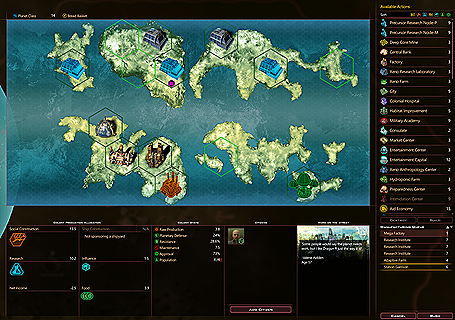
Players can transfer one of their legions from their global pool onto a specific planet so that incoming invaders will have to get through them first.
If the planet has soldiers on it, your civilian population will rise up to help them defend your planet. That is where the resistance value comes into play.
When a player invades a planet that has garrisons on it, they are presented with a screen like this:
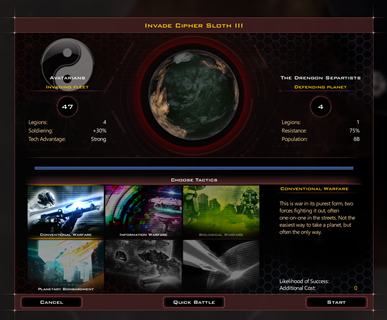
The defender's single legion
When a planet is contested, things get interesting. After choosing their invasion tactic the invader then is presented with a map of the planet's surface:
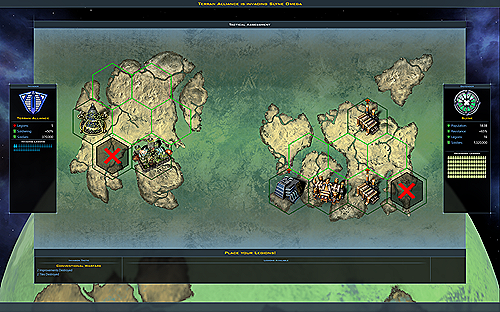
Invaders place their invading legions based on what their objective is.
To conquer a planet, the player must conquer the cities. This puts an interesting dilemma on both the attacker and the defender because any non-city tile that the invader goes through is destroyed.
Thus, an invader with only a single well placed legion may not be able to conquer a planet with 5 garrison legions that are all placed in city centers but it could wipe out most of the planet's infrastructure.
Thus, each player has to carefully consider where they place those legions for battle.
A living galaxy
Crusade is technically an expansion pack. Actually, technically, it's DLC. But we believe most people will find Crusade a whole new game. A lot of the changes are small, but have a big impact.
A few examples:
- New Multicore pathfinding. We'll be doing video demos of this, but the late game performance of Crusade is unlike anything that has ever been seen before in turn-based strategy. That's because Crusade uses all of your CPU cores which means even late game, with dozens of civilizations on massive maps, turns will be reasonably short (it's not magic, however. If you're playing on a 2-core laptop, we can't do much about that).
- Planet Projects. Similar to the missions you can use on your transports, you can queue up projects such as Aid Economy, Aid Research, etc. that will keep your planet busy while also contributing to your overall empire. This matters because you don't end up having to micro dozens of planets on a large map if you don't want to, but also don't end up forgetting about them due to assigning them to a governor or having it on a continual project (we've eliminated continual projects). You can still use governors if you want, but they are not nearly as necessary.
- Tight balance. Whether you're playing Crusade single player or multiplayer, tight balance means that each decision you make has tangible consequences.
- Personality. Each civilization has its own dialog and we've given players the tools to easily add and share their own civilizations with their own dialog.
- Usability. No one throws a parade for UI designers. But UI design is crucial to the enjoyment of games like this. When the choice has been between making a UI "clever" or functional, we've chosen functional.
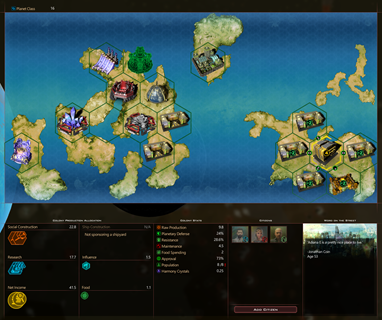
200 turns into the game. The numbers reflect the priorities of the player.
It's little things such as having early planetary improvements act as hubs that get more powerful based on what improvements are constructed adjacent to it. It's making sure all the numbers in the game are the result player choices that don't blow up the balance.
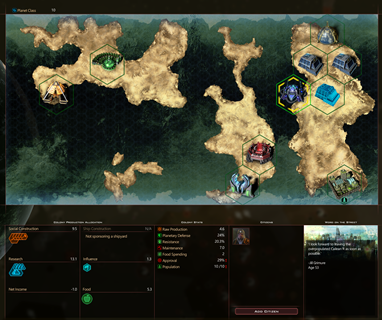
Your people will tell you what they think (see the word of the street quote)
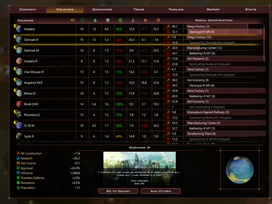
Your planets at your finger tips.
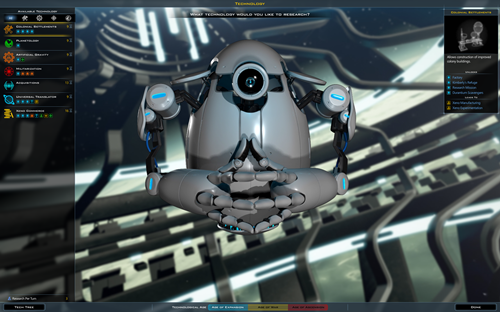
The research screen has been re-designed to maximize usability.
Next up
Next up, we'll get into part 2 of what is in Crusade and why we hope you'll find it to be the ultimate space 4X strategy game. Stay tuned!
Previous Entries: